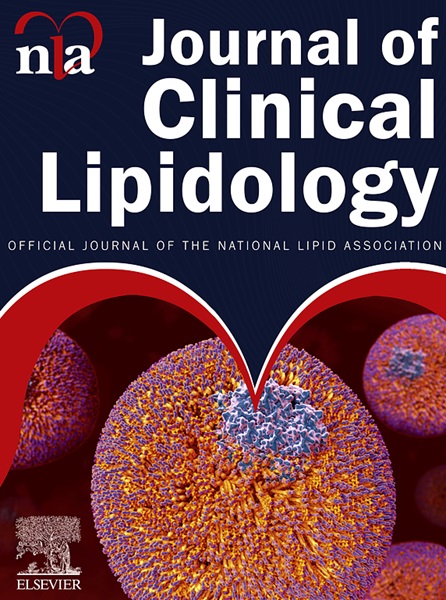Contributing factors to the short-term progression of carotid plaque and its relation to cardiovascular outcomes
IF 4.6
3区 医学
Q2 PHARMACOLOGY & PHARMACY
引用次数: 0
Abstract
BACKGROUND
The temporal changes in carotid plaque progression (PP) and its association with cardiovascular events are not well understood.
OBJECTIVE
This study aimed to evaluate the factors affecting short-term carotid PP and its relation to cardiovascular events.
METHODS
A total of 650 patients who underwent serial carotid ultrasonography over a period of at least 12 months were enrolled and analyzed. The study population was stratified into 2 groups: those with carotid PP (n = 304) and those without PP (n = 346). PP was defined as an increase of plaque number or a ≥20% increase in total plaque thickness compared to previous ultrasonography. The primary endpoint was a 4-year incidence of major adverse cardiovascular events (MACE), defined as a composite of all-cause death, myocardial infarction, coronary revascularization, or stroke.
RESULTS
Among all patients, the initial mean plaque thickness and number were 6.0 ± 6.7 mm and 2.7 ± 2.7, respectively. Upon follow-up, the PP rate was 46.7%, plaque regression was 16.5%, and no change was observed in 36.8%. The incidence of MACE over 4 years was significantly higher in the PP group (26.6%) compared to the no-PP group (13.0%), with a hazard ratio (HR) of 2.19 (95% CI, 1.52-3.15; P < .001). Independent predictors of MACE included age, chronic kidney disease, coronary artery disease, previous stroke, and PP (HR, 2.05; 95% CI, 1.42-2.95; P < .001). Age (HR, 1.02; 95% CI, 1.00-1.03; P = .038) and coronary artery disease (HR, 1.42; 95% CI, 1.04-1.95; P =.030) were independent predictors of PP.
CONCLUSION
Older age and coronary artery disease tended to increase the likelihood of PP during short-term follow-up, which was significantly associated with cardiovascular events.
影响颈动脉斑块短期进展的因素及其与心血管预后的关系。
背景:颈动脉斑块进展(PP)的时间变化及其与心血管事件的关系尚不清楚。目的:探讨影响颈动脉短期PP的因素及其与心血管事件的关系。方法:在至少12个月的时间里,总共有650名患者接受了颈动脉超声检查并进行了分析。研究人群分为2组:颈动脉PP患者(n = 304)和无PP患者(n = 346)。PP定义为斑块数量增加或斑块总厚度较先前超声检查增加≥20%。主要终点是4年主要不良心血管事件(MACE)的发生率,定义为全因死亡、心肌梗死、冠状动脉血运重建术或中风的综合发生率。结果:所有患者的初始平均斑块厚度和数量分别为6.0±6.7 mm和2.7±2.7。随访时,PP率为46.7%,斑块消退率为16.5%,36.8%无变化。PP组4年MACE发生率(26.6%)明显高于无PP组(13.0%),风险比(HR)为2.19 (95% CI, 1.52-3.15;P < 0.001)。MACE的独立预测因素包括年龄、慢性肾脏疾病、冠状动脉疾病、既往卒中和PP (HR, 2.05;95% ci, 1.42-2.95;P < 0.001)。年龄(HR, 1.02;95% ci, 1.00-1.03;P = 0.038)和冠状动脉疾病(HR, 1.42;95% ci, 1.04-1.95;P = 0.030)是PP的独立预测因素。结论:在短期随访中,年龄和冠状动脉疾病倾向于增加PP发生的可能性,并与心血管事件显著相关。
本文章由计算机程序翻译,如有差异,请以英文原文为准。
求助全文
约1分钟内获得全文
求助全文
来源期刊
CiteScore
7.00
自引率
6.80%
发文量
209
审稿时长
49 days
期刊介绍:
Because the scope of clinical lipidology is broad, the topics addressed by the Journal are equally diverse. Typical articles explore lipidology as it is practiced in the treatment setting, recent developments in pharmacological research, reports of treatment and trials, case studies, the impact of lifestyle modification, and similar academic material of interest to the practitioner.
Sections of Journal of clinical lipidology will address pioneering studies and the clinicians who conduct them, case studies, ethical standards and conduct, professional guidance such as ATP and NCEP, editorial commentary, letters from readers, National Lipid Association (NLA) news and upcoming event information, as well as abstracts from the NLA annual scientific sessions and the scientific forums held by its chapters, when appropriate.

 求助内容:
求助内容: 应助结果提醒方式:
应助结果提醒方式:


